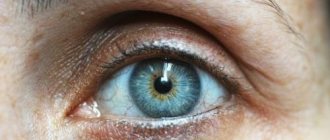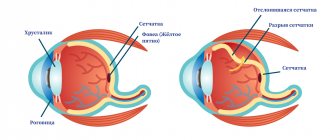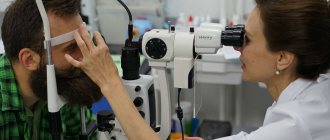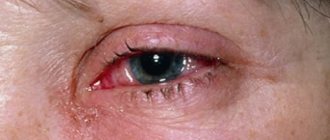Date of article writing: 08/19/2020 Quantity
()
Causes of pathology Symptoms of xerophthalmia Diagnosis Treatment Drug treatment Surgery Hardware treatment Prevention and recommendations
Dry eye syndrome (DES) is a pathological condition in which the conjunctiva and cornea are poorly moisturized. 10-20% of the population of our planet suffers from a similar problem. It occurs much more often in women (70% of cases) than in men.
The pathology is also known under other names - dry keratitis, dry keratoconjunctivitis, xerophthalmia.
Causes of pathology
The main cause of dry eye syndrome is a decrease in the synthesis of tears or their rapid evaporation as a result of changes in properties, which does not allow the formation of a full tear film.
Various factors can provoke the development of pathological dryness:
- long periods of work on a computer that require eye strain;
- air dried by air conditioners and heating devices;
- constant use of contact lenses, which impairs the quality of tears;
- poor nutrition leading to vitamin deficiency (especially vitamin A);
- low-quality cosmetics;
- external influences (ultraviolet radiation, strong wind, smoke);
- a decrease in estrogen synthesis in women during menopause and pregnancy, as a result of which tears become more liquid and are not retained on the cornea;
- injury to the organs of vision;
- incorrectly performed laser vision correction;
- surgical interventions (conjunctivoplasty, keratotomy, photoablation, correction of ptosis) that destabilize tear synthesis;
- taking certain medications (tranquilizers, antidepressants, antihistamines, hormonal contraceptives) that affect hormonal levels (estrogens concentration);
- regular use of eye drops that contain preservatives;
- ophthalmological diseases (conjunctivitis, blepharitis, neuroparalytic keratitis, lagophthalmos, ptosis, stye);
- chronic diseases (diabetes mellitus, Sjogren's syndrome, Felty's syndrome, rheumatoid arthritis, infections, pathologies of the endocrine system);
- hereditary predisposition.
The risk of developing keratoconjunctivitis sicca increases with age - 88% of cases are diagnosed in people over 50 years of age.
Dry eye syndrome
Human tears seem to us like water in which some salts are dissolved, which give the tear fluid a specific, salty-bitter taste. However, in reality there are many more components of a tear, and a tear has a complex, ordered structure - 3 layers.
The middle, so-called aqueous layer, is really water in which microelements are dissolved, and also contains a certain amount of protein and enzymes. To moisturize the ocular surface, tears are produced by accessory glands - they continuously produce small portions of tears, which, when a person moves the eyeball or eyelids, is distributed throughout the eye. If a person cries, experiencing intense emotions, the main lacrimal glands “turn on” - they produce large volumes of tear fluid.
The outer layer of the tear film is a layer of lipids, fat-like substances produced by the meibomian glands. Its main purpose is to slow down the evaporation of the water layer of tears. In addition, the thinnest film of lipids provides additional protection for the eye from small dust particles and is involved in the process of light refraction.
The inner layer of tears (mucin) is produced by the mucous membrane of the eyeball and eyelids. Mucin makes the surface of the eye smooth and promotes uniform distribution of tears over it, retains the water and lipid layers on the ocular surface. In addition, mucin contains active substances that ensure rapid regeneration of the conjunctiva and healing of microscopic damage to it.
In old age, the skin and mucous membranes dry out, and the intensity of tear production also decreases.
This problem is especially often faced by women who, due to the natural endocrine changes that accompany menopause, decrease the level of estrogen in the body, resulting in dryness of the mucous membranes of the body, including the ocular surface (cornea and conjunctiva). In general, dryness of the mucous membranes (including the cornea and conjunctiva) is considered one of the manifestations of menopause. The situation is aggravated by taking hormonal medications, so-called hormone replacement therapy.
Medicines that many older people are forced to take can dry out the mucous membranes, including the surface of the eye.
These medications include, for example, diuretics, which are often included in medications used to treat hypertension, as well as beta blockers and antidepressants. Also, over the years, certain endocrine pathologies can develop, for example, diabetes, rheumatoid arthritis or thyroid diseases; their consequence also often becomes dry mucous membranes of the eyes.
Eye drops with preservatives, which are used for many chronic eye diseases, such as glaucoma, also contribute to changes in the composition of the tear film, causing the development of dry eye syndrome and having a toxic effect on the ocular surface.
If you experience symptoms of dry eyes, discomfort, a feeling of sand in the eyes, fatigue or redness, then for a correct diagnosis and choice of therapy you need to consult an ophthalmologist. For more information about some of the available moisturizing drops, you can take the Find out what's right for you test.
Symptoms of xerophthalmia
The following symptoms are noticeable with dry eye syndrome:
- constant dryness;
- swelling and redness of the conjunctiva;
- feeling the presence of sand;
- discomfort, burning and stinging;
- blurred vision;
- causeless lacrimation;
- mucous discharge;
- photophobia;
- desire to rub your eyes.
In 42-43% of people, vision deteriorates significantly and difficulties arise when reading.
If there is no treatment for dry eye syndrome for a long time, then complications gradually begin to develop, which worsen the quality of life and reduce performance. The cornea becomes thinner, becomes covered with scars, the eye tissue becomes infected, corneal erosions and ulcers form, perforation is possible, and diseases develop (filamentous keratitis, conjunctivochalasis).
Infections and late stages of dry eye syndrome
Xerophthalmia is sometimes a symptom of a serious medical condition, such as Sjögren's syndrome. If dryness is ignored, eye health can deteriorate significantly. Complications develop such as:
- Defect of the cornea in the form of recurrent microerosions. They regularly appear on its surface, causing discomfort to the patient.
- Conjunctival xerosis. The shine of the eyes disappears, plaques appear on the conjunctiva.
- Filamentous keratitis. Pathologies appear on the cornea in the form of pale threads that move along the surface of the eye during blinking. They irritate the mucous membrane, causing itching.
- Dry keratoconjunctivitis. Deformation of the conjunctiva and cornea develops. It is inflammatory and degenerative in nature.
- Deterioration of vision. When the syndrome develops, there is a risk of developing blindness.
Drivers should be especially careful when they have CVD. The pathology reduces concentration while driving and slows down the reaction.
Proper prevention and timely treatment of the syndrome minimize the risk of unpleasant complications. To quickly relieve dry eyes, try using hydrating drops with hyaluronic acid, such as Gilan.
Diagnostics
At the first appointment, the ophthalmologist listens to the patient’s complaints, studies the medical history, and conducts an external examination.
Diagnosis of dry eye syndrome includes special tests:
- fluorescein instillation test - detects dry lesions and calculates the time of tear film rupture;
- Schirmer test (special pieces of paper that absorb tears are fixed under the eyelids for several minutes) – measures the exact total amount of tears produced;
- Norna test (fluorescein is instilled into the eye, the cornea is scanned, noting the time of the first rupture of the tear film) - determines the stability of the tear film, the speed and quality of its evaporation.
If necessary, additional examinations are carried out:
- biomicroscopy – determines the height of the tear menisci, assesses the condition of the conjunctiva, cornea, and tear film;
- thiascopy - examine the organs of vision in polarized light to determine the condition of the lipid layer.
Laboratory tests will also be required:
- crystallography - a drop of tear fluid is applied to a glass slide and then evaporated; the type of pathology is determined from the resulting crystals;
- osmometry – studies the osmolarity of tears, which makes it possible to assess the quality of the tear film and the severity of xerophthalmia;
- cytology of a smear taken from the conjunctiva.
Why are tears needed?
There is a saying: “a small tear heals a great sorrow.” This is not entirely true: crying itself is not a cure at all, but a side effect of hormones secreted by the body to combat stress. And, of course, it is one of the most powerful emotional signals to others. But initially, nature did not create tears to demonstrate deep grief or intense joy.
Our tear glands work constantly, and not just during moments of outburst of emotions.
When a person blinks, the eyelid distributes tears over the surface of the eye in a thin layer—a hundredth of a millimeter—layer. This precorneal tear film is simply necessary for the normal functioning of our visual organs:
- there are no blood vessels in the cornea of the eye, and the flow of oxygen and nutrients into it, as well as the removal of metabolic products, occurs precisely thanks to tears;
- the tear film protects the cornea of the eye from dust particles and pathogens;
- the tear conceals the irregularities of the cornea, thereby helping the eye to see more clearly.
In addition to water, tears contain mucins (proteins that participate in metabolic processes) and lipids (fats). Once the relationship between them is disrupted or tear production in general decreases, the precorneal film ceases to perform its functions.
Treatment
Before treating dry eye syndrome, it is necessary to eliminate the causes of the disease or at least minimize the adverse effects. If the pathological condition is caused by other diseases, the ophthalmologist will refer you to the appropriate specialist.
Correction of pathology is possible in several ways:
- medicinal;
- operational;
- hardware
Drug treatment
Most often, for xerophthalmia, drops with artificial tears are used, which are chosen depending on the severity of the condition. The drops activate the synthesis of tears, improve their properties, and help retain tears on the surface of the cornea.
Additionally, the doctor may prescribe retinol (vitamin A) and omega-3 fatty acids, steroid or hormonal drugs, and immunosuppressants. In case of infection, antibacterial ointments are used.
Surgery
If drug therapy does not have the desired effect, the ophthalmologist will recommend surgery:
- tarsorrhaphy - reduce the palpebral fissure by partially suturing the eyelids to inhibit the evaporation of tears;
- blocking the tear ducts - the ducts are cauterized or punctal plugs are inserted into them, thereby preventing the outflow of tears from the cornea;
- transplantation of salivary glands into the conjunctival cavity;
- keratoplasty - replaces a damaged area of the cornea.
Hardware treatment
The MAKDEL-02 device provides effective results in the treatment of dry eye syndrome:
- has analgesic and anti-inflammatory effects;
- normalizes the functioning of the lacrimal glands;
- relieves vasospasms;
- activates blood circulation;
- improves cell structure;
- accelerates regeneration processes;
- strengthens local immunity.
The device is used for medicinal purposes. If necessary, hardware treatment is combined with drug therapy and laser acupuncture.
Mild dry keratitis
The mild form of dry eye syndrome is characterized by the presence of minor signs of corneal dryness, which occurs against the background of a reflex deficiency of tears. The clinical picture includes photophobia, a burning sensation and “sandiness”.
Delfanto® capsules will help get rid of the unpleasant symptoms of dry eye syndrome. They are based on the standardized MaquiBright® extract, which contains antioxidants that are beneficial for the organ of vision. Capsules provide not only symptomatic relief of the disease, but also affect the causes of its occurrence.
Many patients experience increased lacrimation. In this way, the body tries to compensate for the deficiency of tears.










